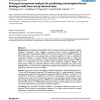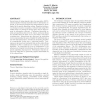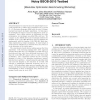3569 search results - page 639 / 714 » On the Evolution of Evolutionary Algorithms |
JACM
2006
14 years 9 months ago
2006
Abstract. Maximum likelihood (ML) is an increasingly popular optimality criterion for selecting evolutionary trees [Felsenstein 1981]. Finding optimal ML trees appears to be a very...
128
click to vote
BMCBI
2005
14 years 9 months ago
2005
Background: The responses to interleukin 1 (IL-1) in human chondrocytes constitute a complex regulatory mechanism, where multiple transcription factors interact combinatorially to...
ATAL
2007
Springer
15 years 4 months ago
2007
Springer
Temporal difference reinforcement learning algorithms are perfectly suited to autonomous agents because they learn directly from an agent’s experience based on sequential actio...
113
click to vote
GECCO
2005
Springer
15 years 3 months ago
2005
Springer
Several ways of using singular value decomposition (SVD), a linear algebra technique typically used for information retrieval, to decompose problems into subproblems are investiga...
GECCO
2010
Springer
15 years 1 months ago
2010
Springer
Derandomization by means of mirrored samples has been recently introduced to enhance the performances of (1, λ) and (1 + 2) Evolution-Strategies (ESs) with the aim of designing f...




